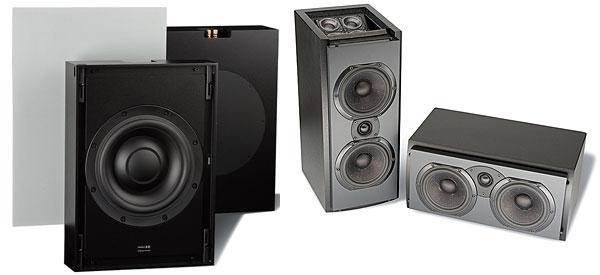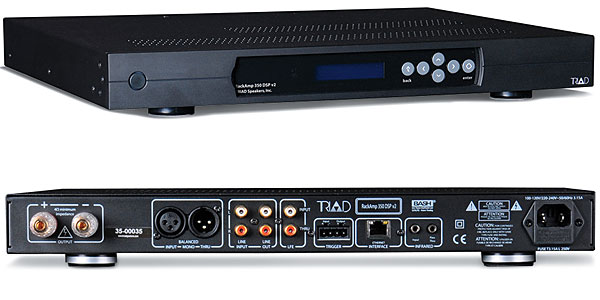Triad Atmos-Enabled InRoom Bronze LR-H Speaker System Review

AT A GLANCE
Plus
Dolby Atmos enabled
Natural, open character
Superb match with InWall Bronze/4 SlimSub
Minus
Atmos operation limits use in cabinets or behind a screen
THE VERDICT
Awesome for Atmos and awesome at most everything else.
Nine out of 11.4 people (approximately) reading this report are thinking, “Who the hell is Triad?” (Hopefully, fewer folks are asking, “What the hell is Atmos?” If you’re one of them, hang in there. I’ll get to Atmos in a bit.) To answer the original question, Triad is a Swiss Army Knife-like manufacturer of custom-installed speakers. That is, regardless of the particular application, Triad has a blade—er, speaker—designed and built for it (in the U.S. of A., by the way). You need in-room, in-ceiling, or in-wall speakers? Check. Invisible in-wall speakers? Ditto. OK, what kind of subwoofer do you want? The standard in-room or an in-wall design? Yes and yes. (Yawn.) Why not try something a little less common, like one of Triad’s on-wall, in-cabinet, or in-ceiling subwoofers? Then there’s Triad’s esoteric and rather sinister-looking FlexSub, which includes an expandable, flexible tube that channels the bass output from the hidden subwoofer cabinet to a remotely located grate or grille.
Anyone who’s not impressed by now should be because, well, that’s a pretty damn impressive range of speaker styles. And the list above doesn’t even include the model that’s the subject of this review: Triad’s first Dolby Atmos–enabled speaker, the InRoom Bronze LR-H. (The company also recently announced the somewhat larger InRoom Silver LR-H, at a cost of $1,500 each compared with $1,000 each for the InRoom Bronze LR-H).
Don’t Be Baffled by Atmos
If you’re a little hazy or completely in the dark about Atmos, you’re in exactly the opposite position that Triad is in: The company worked closely with Dolby to help develop the standard for Atmos-enabled speakers. In this case, it means Triad should have a pretty good idea of what they’re doing, and maybe even a little advantage over other speaker manufacturers when it comes to designing and engineering speakers for Atmos, at least, those that use up-firing elevation speakers for the height channels.
Triad’s InRoom Bronze LCR—the speaker on which the InRoom Bronze LR-H is based—isn’t a totally new speaker. Nor is its tonally matched architectural sibling, the InCeiling Bronze/8 LCR. Similarly mature is the InWall Bronze/4 SlimSub (of which Triad sent four, along with each one’s dedicated 350-watt companion amp with required internal equalization for each, to use as part of the test systems in my feature story “Dolby Atmos vs. Dolby Atmos” on page 30). The InRoom Bronze Center, a dedicated center-channel speaker also reviewed here, is a relatively new model based on the InRoom Bronze LCR, but with an offset tweeter. And the InRoom Bronze LR-H is so new that you can almost still smell the ink from the CAD drawing printouts.
 Standing just over 19 inches tall, the Bronze LR-H isn’t what you’d call a mini monitor. Nor is it a classic bookshelf speaker, due to the Atmos-enabled module integrated into the top of the speaker’s cabinet, which needs an acoustically unobstructed path to the ceiling.
Standing just over 19 inches tall, the Bronze LR-H isn’t what you’d call a mini monitor. Nor is it a classic bookshelf speaker, due to the Atmos-enabled module integrated into the top of the speaker’s cabinet, which needs an acoustically unobstructed path to the ceiling.
The speakers that Triad sent were finished in matte black with black metal grilles on the front and top of the cabinet. As such, the LR-H isn’t going to win any beauty contest (Triad knowingly doesn’t include a swimsuit for the speaker), but it’s not ugly. File the description of its cosmetics under “Plain, Nondescript, Black Box with a Grille.”
Basic black, however, is but the beginning. Since Triad builds everything in-house, one item at a time, the company is able to offer “an unlimited array of custom veneer finishes and custom paint matching to blend with your environment.” (I doubt that “unlimited” includes Truffula Tree wood veneers, but we’ll let that pass. Chameleon probably isn’t on the list, either.) So if you want your speakers to be loud—visually, that is—Triad can do it.
Regardless of the color of the cabinet, behind the curved, metal, perforated grille on the front are two 5.5-inch proprietary cone drivers and a single 1-inch fabric-dome, neodymium tweeter, arranged in an acoustic sandwich configuration (also known as a D’Appolito array). The cabinet is a sealed enclosure that’s built like a brick sh—, uh, “bank vault,” as Triad describes it.
There’s no indication on the front of the Bronze LR-H that this is an Atmos-enabled speaker. It only starts to dawn on you when you peer in through the metal mesh grille on the top of the cabinet (your first clue) and see a cluster of four full-range 2-inch cone neodymium drivers (your second clue). The drivers are mounted in a square pattern, all on the same baffle, which is angled 20 degrees forward (your third clue). Opposite that baffle is a rear-facing, much more steeply angled panel treated with acoustic foam in order to minimize unwanted reflections that would otherwise occur with a flat surface so close to these drivers.
On the back of the cabinet are two sets of binding posts. The top pair is for the Atmos-enabled section. The bottom two posts are for the forward-firing drivers. Remember that your system’s overhead channels—front and rear—are independent channels requiring their own amplification, which means you’ll have to run two sets of speaker wires to each Atmos-enabled speaker. (Wireworld, Monster Cable, AudioQuest, and a spool-ful of other wire companies have already sent thank-you cards to Dolby.) Since the driver sections are independent, though, the upfiring section of the Bronze LR-H won’t be active when you’re not using the appropriate processing in your AVR or pre/pro.
To begin with, the Atmos-enabled section stays dead quiet when you’re listening to two-channel or non-Dolby multichannel sources. (You can, of course, use the Atmos renderer in your AVR or pre/pro to upmix Atmos-less content, if so desired.) Triad has always taken great pains to ensure that all speaker models in a given series—the Bronze, Silver, Gold, and Platinum collections, for example—sound as much like each other as possible. In other words, the InCeiling Bronze/8 LCR is supposed to mimic the performance of the InWall Bronze/4 LCR, both of which are intended to compliment the InRoom Bronze LCR and Center note for note.

The InRoom Bronze/4 SlimSub and RackAmp 350 DSP v2 combo utilized here was previously reviewed by me in 2013 with the original version 1 RackAmp 350; the full review with ratings is available at soundandvision.com. The passive sub features a 10-inch aluminum long-throw woofer mounted in a sealed cabinet that’s only 13.5 x 19 x 4 inches (WxHxD) and hence fits easily in most normal wall cavities. The discrete RackAmp packs 350 watts (mono), but that’s only part of the story. You can also calibrate the hell out of it thanks to extensive DSP fine-tuning for the crossover and built-in EQ, all of which can be accessed via the RackAmp’s Ethernet port, your home network, and a web browser.
- Log in or register to post comments
































































